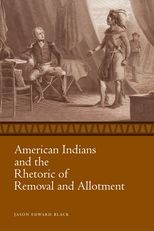American Indians and the Rhetoric of Removal and Allotment
American Indians and the Rhetoric of Removal and Allotment
Cite
Abstract
Situating U.S. governmental and American Indian rhetoric in a colonial context, Native Dualities examines the ways that both the government’s rhetoric and American Indian voices contributed to the policies of Native-U.S. relations throughout the removal and allotment eras. These discourses co-constructed the silhouette of both the U.S. government and American Indian communities and contributed textures to the relationship. Such interactions – though certainly not equal between the two – illustrated the hybrid-like potentialities of Native-U.S. rhetoric in the nineteenth century. That is, both colonizing discourse and decolonizing discourse added arguments, identity constructions, and rhetorical moves to the colonizing relationship. Native Dualities demonstrates how American Indians decolonized dominant rhetoric in terms of impeding the realization of the removal and allotment policies. Likewise, by turning around the U.S. government’s discursive frameworks and inventing their own rhetorical tactics, American Indian communities helped restyle their own and the government’s identities. Interestingly, during the first third of the twentieth century, Native decolonization was shown to impact the Native-U.S. relationship as American Indians urged for the successful passage of the Indian Citizenship Act of 1924 and the Indian New Deal of 1934. In the end, Native communities were granted increased rhetorical power through decolonization, though the U.S. government still retained a powerful colonial influence over them. This duality of inclusion (controlled citizenship) and exclusion (controlled sovereignty) was built incrementally through the removal and allotment periods, and existed as residues of nineteenth century Native-U.S. rhetorical relations.
-
Front Matter
- Introduction Colonization and Decolonization in the Native-US Relationship
- One The Ties That Colonize: Rhetoric from Nationhood to Removal
- Two Governmental Colonizing Rhetoric During Indian Removal
- Three Native Decolonial Resistance to Removal
- Four Colonization and the Solidification of Identities in the General Allotment Act
- Five Pan-Indianism and Decolonial Challenges to Allotment
- Conclusion Identity Duality and the Legacies of Colonizing and Decolonizing Rhetoric
-
End Matter
Sign in
Personal account
- Sign in with email/username & password
- Get email alerts
- Save searches
- Purchase content
- Activate your purchase/trial code
Institutional access
-
Sign in through your institution
- Sign in with a library card Sign in with username/password Recommend to your librarian
Institutional account management
Sign in as administratorPurchase
Our books are available by subscription or purchase to libraries and institutions.
Purchasing information| Month: | Total Views: |
|---|---|
| October 2022 | 1 |
| October 2022 | 4 |
| October 2022 | 1 |
| November 2022 | 3 |
| November 2022 | 4 |
| November 2022 | 3 |
| April 2023 | 3 |
| April 2023 | 2 |
| November 2023 | 2 |
| November 2023 | 3 |
| November 2023 | 2 |
| November 2023 | 2 |
| November 2023 | 2 |
| November 2023 | 1 |
| November 2023 | 2 |
| November 2023 | 2 |
| January 2024 | 2 |
| January 2024 | 2 |
| January 2024 | 2 |
| January 2024 | 4 |
| January 2024 | 2 |
| February 2024 | 1 |
| February 2024 | 2 |
| February 2024 | 3 |
| February 2024 | 2 |



Get help with access
Institutional access
Access to content on Oxford Academic is often provided through institutional subscriptions and purchases. If you are a member of an institution with an active account, you may be able to access content in one of the following ways:
IP based access
Typically, access is provided across an institutional network to a range of IP addresses. This authentication occurs automatically, and it is not possible to sign out of an IP authenticated account.
Sign in through your institution
Choose this option to get remote access when outside your institution. Shibboleth/Open Athens technology is used to provide single sign-on between your institution’s website and Oxford Academic.
If your institution is not listed or you cannot sign in to your institution’s website, please contact your librarian or administrator.
Sign in with a library card
Enter your library card number to sign in. If you cannot sign in, please contact your librarian.
Society Members
Society member access to a journal is achieved in one of the following ways:
Sign in through society site
Many societies offer single sign-on between the society website and Oxford Academic. If you see ‘Sign in through society site’ in the sign in pane within a journal:
If you do not have a society account or have forgotten your username or password, please contact your society.
Sign in using a personal account
Some societies use Oxford Academic personal accounts to provide access to their members. See below.
Personal account
A personal account can be used to get email alerts, save searches, purchase content, and activate subscriptions.
Some societies use Oxford Academic personal accounts to provide access to their members.
Viewing your signed in accounts
Click the account icon in the top right to:
Signed in but can't access content
Oxford Academic is home to a wide variety of products. The institutional subscription may not cover the content that you are trying to access. If you believe you should have access to that content, please contact your librarian.
Institutional account management
For librarians and administrators, your personal account also provides access to institutional account management. Here you will find options to view and activate subscriptions, manage institutional settings and access options, access usage statistics, and more.